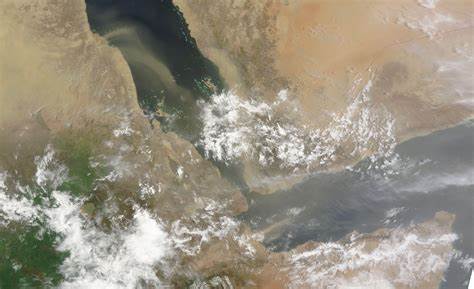Dust Storm Over the Red Sea

Dust Storm Over the Red Sea. On June 16, 2004, a huge plume of dust blew out of the deserts of Sudan and Eritrea and over the southern Red Sea. The plume grew dramatically in size over the course of a few hours, as is shown in these Moderate Resolution Imaging Spectroradiometer (MODIS) images. The earlier MODIS image, from the Terra satellite, shows a much more compact, almost completely opaque plume. When the Aqua satellite flew over a few hours later, the plume had spread over the Red Sea.
The bulk of the plume narrowly missed covering Port Sudan, which lies about halfway up the vertical strip of coastline. It also missed covering the Dahlak Archipelago by a much greater margin, though a thin veil of dust still managed to reach that far. This archipelago is visible at the bottom right corner of the image. It has been known since Roman times as a source of pearls.
The Red Sea (Arabic: البحر الأحمر Al Baḥr al aḥmar, Hebrew: Yam Soof ים סוף or Hayam Haadom הים האדום, Coptic: ⲫⲓⲟⲙ `ⲛϩⲁϩ Phiom Enhah or ⲫⲓⲟⲙ ̀ⲛϣⲁⲣⲓ Phiom ̀nšari, ܝܡܐ ܣܘܡܩܐ Yammāʾ summāqā Tigrinya: ቀይሕ ባሕሪ Qeyih Bahri, Somali: Badda Cas) is a seawater inlet of the Indian Ocean, lying between Africa and Asia. Its connection to the ocean is in the south, through the Bab el Mandeb strait and the Gulf of Aden. To its north lie the Sinai Peninsula, the Gulf of Aqaba, and the Gulf of Suez (leading to the Suez Canal). It is underlain by the Red Sea Rift, which is part of the Great Rift Valley.
The Red Sea has a surface area of roughly 438,000 km2 (169,100 mi2), is about 2250 km (1398 mi) long, and — at its widest point — 355 km (220.6 mi) wide. It has an average depth of 490 m (1,608 ft), and in the central Suakin Trough it reaches its maximum depth of 3,040 m (9,970 ft).
The Red Sea also has extensive shallow shelves, noted for their marine life and corals. The sea is the habitat of over 1,000 invertebrate species and 200 types of soft and hard coral. It is the world’s northernmost tropical sea, and has been designated a Global 200 ecoregion.
Credit: Jeff Schmaltz, MODIS Rapid Response Team, NASA/GSFC
News coming your way





















